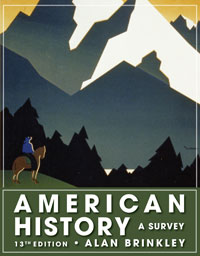1 A) increased public funding of schools, housing, veterans' benefits, welfare, and interstate highways. B) massive military spending inspired by the Cold War. C) the "baby boom" and rapid expansion of the suburbs. D) increased spending on social programs. E) All these answers are correct. 2 A) the 20 percent of Americans who lived in poverty in the 1950s B) the discrimination suffered by minorities C) the discontent of many American women in their traditional roles D) the discontent of returning veterans E) All these answers are correct. 3 A) Northeast B) Southeast C) Midwest/Great Plains D) West E) New England 4 A) a decrease in government spending. B) corporate mergers and the formation of conglomerates. C) equitable distribution of corporate profits. D) the survival and renewal of the family farm. E) a decrease in military spending. 5 A) the merger of the AFL and CIO to create the giant federation, the AFL-CIO. B) fairly stable membership numbers. C) greater success in organizing new workers than in winning benefits for workers already organized in strong unions. D) signs of corruption and indifference among some labor leaders as the unions themselves became wealthy, powerful bureaucracies. E) booming corporations' reluctance to allow strikes. 6 A) restless search by individuals for identity and purpose. B) quest for economic political justice within the United States. C) absorption with consumer goods by a growing middle class. D) isolationist desire to avoid international affairs or commitments. E) collective desire to rid the world of communism. 7 A) variety and excitement in lifestyles and entertainment. B) racial integration in neighborhoods and schools. C) greater opportunities for cultural and educational advancement. D) larger, safer, and more private homes. E) a chance to obtain individuality. 8 A) fulfill their career and professional goals. B) resist pressures to stay at home to raise a family. C) share the role of parenting equally with the fathers. D) work to supplement the family income. E) subordinate their activities and interests to the needs of their children. 9 A) affected only a small percentage of the total population. B) encouraged independent value formation among members of the white middle class. C) heightened the sense of alienation and powerlessness among minority groups. D) failed to attract significant interest from commercial advertisers. E) saw a rapid decline in popularity. 10 A) medical researchers. B) professional athletes. C) mothers. D) industrial tycoons. E) astronauts. 11 A) drained Americans of self-reliance. B) made Americans more focused on their own values and less on the concerns of society. C) allowed only men to find fulfillment in American society. D) focused too much on the needs of the youth culture. E) called for Americans to engage in too much independent thought. 12 A) fought for more racial inclusion in American society. B) came predominantly from the thriving new cultural centers on the West Coast. C) tried to resist the conformity of American culture in the 1950s. D) became the basis of the youth rebellion movement of the 1950s. E) were strong supporters of organized society. 13 A) ordering the governor to be arrested. B) negotiating a settlement that delayed local integration for a three-year "cooling-off" period. C) sending federal troops to uphold the court order. D) refusing to involve the federal government in what he considered to be strictly a state matter. E) supporting the resistance. 14 A) Malcolm X B) H. Rap Brown C) Stokely Carmichael D) Martin Luther King, Jr. E) Earl Warren 15 A) the Oppenheimer case. B) his expulsion from the Senate. C) the reports that he was an alcoholic. D) his behavior in the Army-McCarthy hearings. E) his opposition to the Brown v. Board of Education decision. 16 A) liberation. B) containment. C) mutual security. D) integration. E) massive retaliation. 17 A) the rise of military pacifism. B) the tendency to hysterical anticommunism. C) the risk of creeping socialism. D) the influence of the military-industrial complex. E) the rise of racism in America. 18 A) Alexander Fleming B) Almorth Wright C) Jonas Salk D) Edward Jenner E) John Foster Dulles 19 A) stalemate in the Korean War B) Eisenhower's election in 1956 C) Eisenhower's election in 1952 D) the Soviet launch of Sputnik E) the Brown v. Board of Education decision 20 A) Hetch Hetchy B) Love Canal C) Sputnik D) Echo Park E) entreaties of the United Fruit Company 21 A) Charles Wilson B) John Foster Dulles C) Dwight Eisenhower D) Dick Clark E) Fidel Castro





